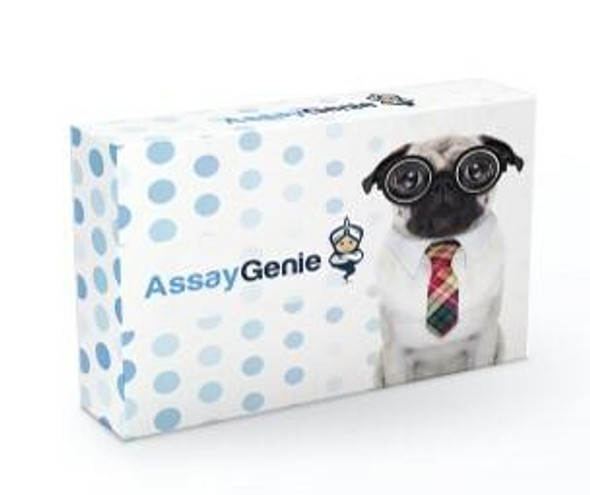Description
Human ANGII PharmaGenie ELISA Kit
| Product SKU: | SBRS0005 |
| Size: | 96T |
| Application: | This kit can theoretically detect all active angiotensins, including ANGI, ANGII, ANGIII and ANGIV as well as inactive angiotensinogen. Cross Reactivity: This ELISA kit shows no cross-reactivity with any of the cytokines tested: Ghrelin, Nesfatin, NPY and APC. |
| Uniprot: | P01019 |
| Gene ID: | 183 |
| Gene Names: | AGT / SERPINA8 |
| Synonyms: | Angiotensinogen (Serpin A8) [Cleaved into: Angiotensin-1 (Angiotensin 1-10) (Angiotensin I) (Ang I) Angiotensin-2 (Angiotensin 1-8) (Angiotensin II) (Ang II) Angiotensin-3 (Angiotensin 2-8) (Angiotensin III) (Ang III) (Des-Asp[1]-angiotensin II) Angiotensin-4 (Angiotensin 3-8) (Angiotensin IV) (Ang IV) Angiotensin 1-9 Angiotensin 1-7 Angiotensin 1-5 Angiotensin 1-4] |
| Target Species: | Human, Mouse, Rat |
| Compatible Sample Types: | Cell Culture Supernatants, Serum |
| Design Principle: | Competition-based |
| Method of Detection: | Colorimetric |
| Quantitative/Semi-Quantitative: | Quantitative |
| Range: | 0.1-1,000 pg/ml |
| Sensitivity: | 0.3 pg/ml |
| Recommended Dilution: | Human: 4X, Mouse: 2X, Rat: 2X |
| Storage/Stability: | Standard, Biotinylated Angiotensin II peptide, and Positive Control should be stored at -20°C after arrival. Avoid multiple freeze-thaws. The remaining kit components may be stored at 4°C. Opened Microplate Wells and antibody (Item N) may be stored for up to 1 month at 2 to 8°C. Return unused wells to the pouch containing desiccant pack and reseal along entire edge. |
- Pre-Coated 96-well Strip Microplate
- Wash Buffer
- Standard Peptide
- Assay Diluent(s)
- Biotinylated Peptide
- HRP-Streptavidin
- TMB One-Step Substrate
- Stop Solution
- Assay Diagram
- Positive Control Sample
- Capture Antibody
- Technical Manual
Other materials and equipment required:
The Assay Genie Human ANGII PharmaGenie ELISA Kit (SBRS0005) will require other equipment and materials to carry out the assay. Please see list below for further details.
- Distilled or deionized water
- Precision pipettes to deliver 2 ul to 1 ml volumes
- Adjustable 1-25 ml pipettes for reagent preparation
- 100 ml and 1 liter graduated cylinders
- Tubes to prepare standard and sample dilutions
- Orbital shaker
- Aluminum foil
- Saran Wrap
- Absorbent paper
- Microplate reader capable of measuring absorbance at 450nm
- SigmaPlot software (or other software that can perform four-parameter logistic regression models)
- Prepare all reagents, samples and standards as instructed.
- Add 100 ul detection antibody to each well.
- Incubate 1.5 h at RT or O/N at 4°C.
- Add 100 ul standard or sample to each well.
- Incubate 2.5 h at RT.
- Add 100 ul prepared streptavidin solution.
- Incubate 45 min at RT.
- Add 100 ul TMB One-Step Substrate Reagent to each well.
- Incubate 30 min at RT.
- Add 50 ul Stop Solution to each well.
- Read plate at 450 nm immediately.
Angiotensin, a key player in the renin-angiotensin system, is a peptide hormone that causes vasoconstriction, increased blood pressure, and release of aldosterone from the adrenal cortex. It is derived from the precursor molecule angiotensinogen produced in the liver. Angiotensin II is formed from Angiotensin I, which is removed of two terminal residues by the enzyme Angiotensin-converting enzyme (ACE). Angiotensin II acts as an endocrine, autocrine/ paracrine, and intracrine hormone. Angiotensin II is degraded to angiotensin III by angiotensinases that are located in red blood cells and the vascular beds of most tissues. It has a half-life in circulation of around 30 seconds, while in tissue, it may be as long as 15-30 minutes. The effect of obesity on Angiotensin II has recently been reported. Obese patients show heightened renal vasodilation to blockade of the renin-angiotensin system, suggesting deficits in vascular responses to angiotensin II. This may due to increased reactivity of renal vasoconstriction to ANG II. Angiotensin II has been associated with a number of important physiological processes in heart, brain, adrenal gland and kidney. For cardiovascular effect, Angiotensin II is a potent direct vasoconstrictor, constricting arteries and veins and increasing blood pressure. It is also the most important Gq stimulator of the heart during hypertrophy. For neural effects, Angiotensin II increases thirst sensation (dipsogen) through the subfornical organ (SFO) of the brain, decreases the response of the baroreceptor reflex, and increases the desire for salt. It increases secretion of ADH in the posterior pituitary and secretion of ACTH in the anterior pituitary. For adrenal effects, Angiotensin II acts on the adrenal cortex, causing it to release aldosterone. For renal effects, Angiotensin II has a direct effect on the proximal tubules to increase Na+ absorption.




